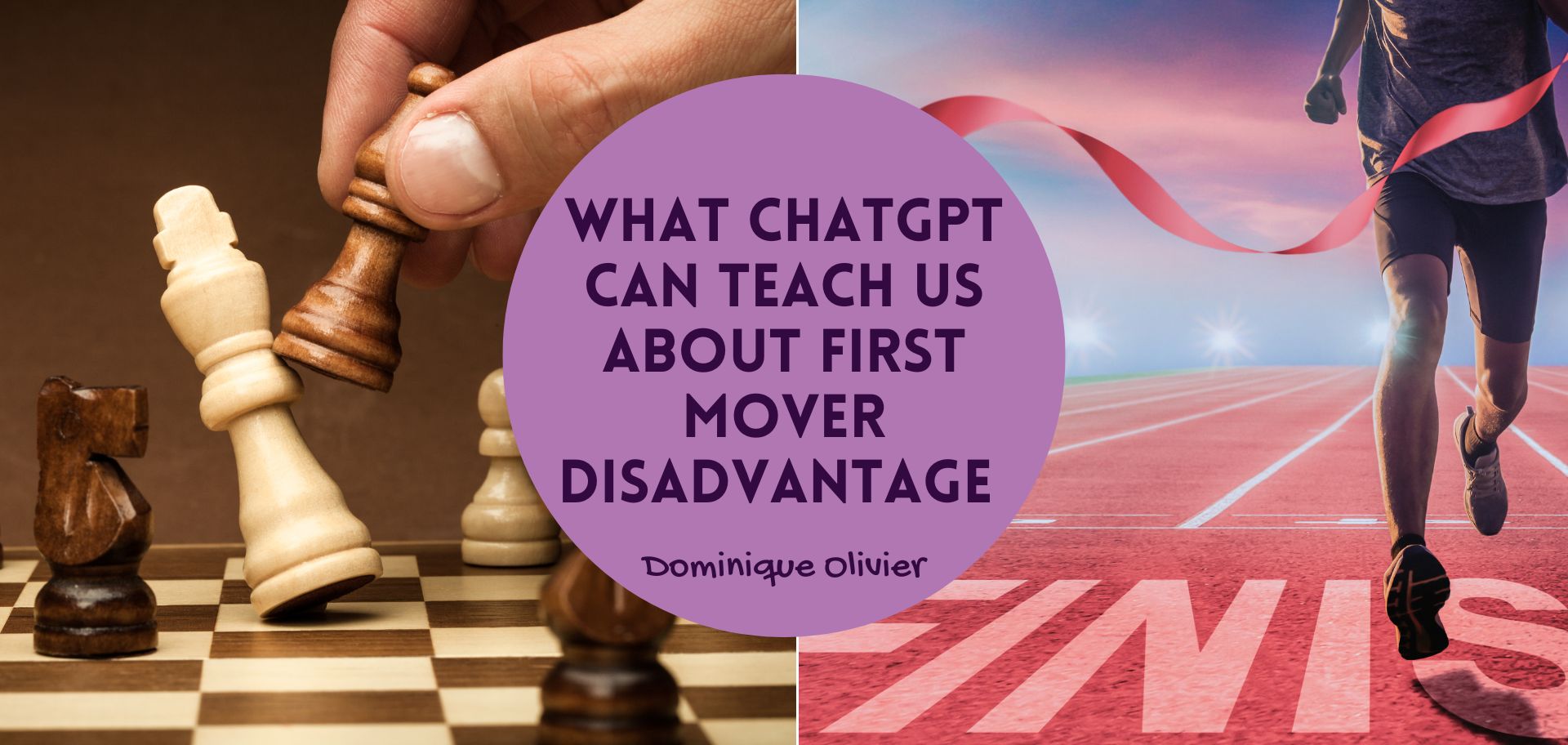Just because you macheted a new trail through the jungle, doesn’t guarantee you’ll be the first one to reach El Dorado. Sometimes, the same path to innovation is the one that makes it that much easier for your competitors to catch up with you.
Since its debut in 2022, ChatGPT has become the fastest-growing consumer app in internet history. Its parent company, OpenAI, went from zero to more than $1 billion in revenue last year – and that’s fast even by Silicon Valley standards. You would expect this to be the startup success story of the decade, if not the century. However, the tech company that has thrown half the world into panic and the other half into giddy excitement has yet to turn a profit. And while OpenAI’s numbers are still being inked in red, competitors are catching up fast.
The pros and cons of pioneering
You can think of a first mover in any industry as a sprinter who gets a head start in a race. By being the first to introduce a new product or service, they effectively start a lap ahead of all the other runners. Their early entrance gives them a chance to build a strong brand and loyal customer base before any competitors show up. It also gives them some breathing room to fine-tune their offering, and maybe even a chance to set the market price.
However, once a first mover gets going, competitors take off from their starting blocks, hoping to get into the slipstream of that success and snag a piece of the action. If the original pioneer has a big enough head start, a solid market share and dedicated customers, or the stamina to keep innovating, there’s a good chance that they can stay ahead of the pack. More often than not, they find themselves getting overtaken eventually.
In the rush to be the first, a company might cut corners or skip essential features just to launch quickly. If the initial product doesn’t hit the mark with consumers, competitors are then incentivised to take advantage by offering something that better meets customer needs. So, while the first mover takes on the heavy lifting and risks, later entrants can often swoop in with a polished product and win over the market.
They have the benefit of hindsight, even if it wasn’t their own.
The context: how ChatGPT is (and isn’t) making money
OpenAI started as a nonprofit, using around $130.5 million in donations to fund its research and development while committing to share its findings through open-source projects. But in 2019, the company shifted gears and restructured into a limited partner model, blending nonprofit and for-profit elements. They created a for-profit subsidiary that could issue equity and attract top talent, while employees working on profit-driven projects moved to this new entity.
This reorganisation allowed OpenAI to bring in venture capital, blending cutting-edge research with commercial ventures like ChatGPT subscriptions, aimed at making AI accessible and affordable. Importantly, the for-profit arm is bound to the nonprofit’s mission, with profits capped at 100 times any investment. The same nonprofit board continues to oversee all OpenAI activities.
The bulk of OpenAI’s revenue comes from licensing fees for its AI models and products. Pricing access is based on tokens, which represent the number of words generated. It also earns through partnerships, with Microsoft being the most notable partner. Microsoft invested $10 billion in 2023, pushing its total investment to $13 billion. This partnership helps OpenAI reach a broad customer base, offering API access to enterprises and developers alike. Microsoft uses OpenAI’s tech in its Bing search engine’s Copilot tool.
In just nine months post-launch, ChatGPT had been adopted by teams in over 80% of Fortune 500 companies, including big names like Block, Canva, Carlyle, The Estée Lauder Companies, PwC, and Zapier. To boost revenue further, OpenAI introduced ChatGPT Plus, a premium version of the chatbot priced at $20 per month, offering priority access to subscribers. Free users still have access, but only to older versions (like 3.5 instead of 4.0), which may experience downtimes during high demand.
OpenAI has raised a total of $13.5 billion over ten funding rounds, with investors like Thrive Capital, Founders Fund, Arrowshare Ventures, angel investor Thomas Witt, and E1 Ventures getting involved. The company also supports AI startups through its $100 million OpenAI Startup Fund, launched in May 2021, offering consulting and product commercialisation help.
It all sounds great on paper, but despite generating more than $1 billion in revenue in 2023, OpenAI hasn’t yet turned a profit. The development of ChatGPT-4 alone reportedly cost $540 million.
If OpenAI does reach profitability, Microsoft will first recover its investment with a 75% share of the profits and will then receive a 49% share up to $92 billion in profits. As of December 2023, OpenAI was in talks to raise new funding, potentially valuing the company at $100 billion, up from an $86 billion valuation earlier in the year. Co-founder Sam Altman is also exploring up to $7 billion in funding to invest in semiconductor infrastructure to support the AI industry’s growing needs.
Hurdles on the horizon
OpenAI may have been first out the gate, but whether or not it has the legs to stay in the lead remains to be seen.
1. An expensive lead
Jumping into the game early comes with a hefty price tag. For OpenAI, creating ChatGPT meant pouring a ton of resources into research and development. This kind of investment can put a lot of pressure on a company, especially when competitors can simply mimic the technology at a fraction of the cost. The stats speak for themselves: various online sources suggests that it costs approximately 60% to 75% less to replicate an existing product than it does to create a new one. In the case of OpenAI, this means that even with substantial revenue, profitability remains a distant goal, given the massive upfront costs. Meanwhile, competitors like Copilot (created with OpenAI’s own technology) and Llama are free to innovate from a much smaller cost base.
2. Regulations and other headaches
One of OpenAI’s biggest challenges has been keeping up with and anticipating regulations around data privacy, AI ethics, and misuse of technology. As the first mover, they often face the brunt of regulatory scrutiny, making them the guinea pig for policymakers figuring out how to handle new tech (not to mention the recipient of multiple lawsuits). The rules aren’t always clear, and the stakes are high. A company in this position needs to move with extreme caution, often slowing down to ensure compliance, while competitors can watch and learn from their experience.
3. Innovation fatigue is a real thing
Continuously rolling out new versions like GPT-4 is exhilarating but also exhausting. It’s a relentless cycle of development and improvement to stay ahead. Keeping the excitement alive while managing expectations becomes a constant balancing act. While innovators have run a hard race already, competitors with fresher legs are able to execute on their ideas with greater speed and efficiency.
4. Investor scepticism
Securing funding as a first mover is often a challenging feat. Investors tend to be cautious with unproven innovations, opting instead for projects that have already demonstrated viability. OpenAI had to overcome this scepticism, convincing backers that their advanced AI technology was more than just a fleeting trend. And, truth be told, the full potential of their innovation is still being debated. Even with heavyweights like Microsoft on board, there’s no guarantee that future funding rounds for the next iteration of GPT will be smooth sailing. On the other end of the spectrum, competitors who have built on OpenAI’s foundational work might find it easier to attract investment, as the technology’s market acceptance has already been established.
The danger for pioneers
So, is there a lesson to be taken from the trials and tribulations of ChatGPT? Having done the research, I would say this: being recognised as a creative genius is nice, but for most businesses, making money is even nicer. Beware of the lure of pioneering – the world needs new ideas, sure, but how many of those are still around (remember that article on Stigler’s Law)? Far more profitable, in my opinion, to refine an existing idea based on consumer feedback than to risk it all on invention and still be overtaken.
Perhaps the greater question, which I will leave unanswered, is why we remain motivated to keep creating new things, despite these clear risks. Maybe it’s because we know that between pioneering and profiteering, there’s only one that truly moves the world forward.
About the author: Dominique Olivier

Dominique Olivier is the founder of human.writer, where she uses her love of storytelling and ideation to help brands solve problems.
She is a weekly columnist in Ghost Mail and collaborates with The Finance Ghost on Ghost Mail Weekender, a Sunday publication designed to help you be more interesting.
Dominique can be reached on LinkedIn here.





Nice article. Thx
Granted invention without proper patenting is like clearing a thick forest for others to plant and harvest bountifully from your efforts. Yet there is something among humans which inspire us to continue looking at new ways of doing things. For Big Tech, money will be eventuallly be made when a way to monetise an invention is discovered. Take Google and Facebook, for example, which initially were difficult to justify as investment cases. No serious conservative value investor would .have considered these two in his/her portolio.. Today, we are told, Google is making money the equivalent of CHATGPT’s 2023 revenue in interest income alone!!!
Competition is really any busines leader’s worst nightmare.. it is even scary when competitors are no longer ONLY interested in how your products are performing in the market, but how your whole company is performing. If a competitor has the guts and audacity to swallow industry titan like Anglo Ameican whole, then you then wonder as to the fate of minnows.